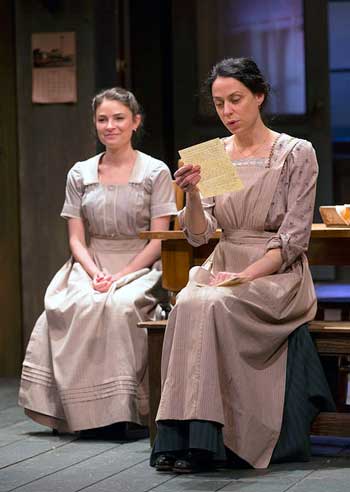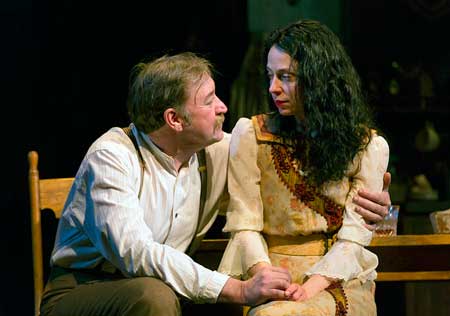Play (2015)
by Ronan Noone
World Premiere
Directed by Campbell Scott
Scenic and Costume Design: Santo Loquasto; Lighting Design; James F. Ingalls
Huntington Theatre Company
Boston Center for the Arts
South End, Boston
January 16 – February 21, 2015
With Kathleen McElfresh (Bridget O’Sullivan), Christopher Donahue (Jack Smythe), MacKenzie Meehan (Cathleen O’Leary)

Kathleen McElfresh as Bridget
in “The Second Girl”
Photo: T. Charles Erickson
Courtesy of Huntington Theatre Company
Bridget (Kathleen McElfresh) and Cathleen (MacKenzie Meehan) are aunt and niece, in service at the Tyrone household, the fictional family famous from its depiction in Eugene O’Neill’s Long Day’s Journey Into Night. In fact, the date of the setting of The Second Girl and that of the O’Neill tragedy, in August 1912, are the same. Here, we see the downstairs view of the upstairs portrayed in O’Neill’s work.
Bridget is, at 32, breathing on middle-age and caught up in – one might more exactly say caught by – her job and resigned to a life of service. Cathleen, the eponymous second girl, is a decade younger, more adventurous, and willing to take risks. Jack (Christopher Donahue), the forty-year-old chauffeur for the family, tries to appeal to Bridget’s well-camouflaged romantic side with limited success, and the question arises whether any of them will break out of their current molds and seek a change.
These characters are beautifully drawn, and an astute representation of types within this class of Irish immigrants. In fact, not quite immigrants, but permanent residents bent on supporting family back in Ireland, they exhibit much of the divided sensibility reflective of that state. Not able to go home nor comfortable in staying, they lead a double life, their hearts in Ireland and their liveleihoods in America. Those contained and fearful get swallowed by this duality, while those with pluck and gusto seem able to break out of it to begin a new life on this side of the Atlantic.
The pretense of this play set downstairs in the Tyrone household is a cute trick, but effectively no more than an initial hook for the audience. There is really nothing significant about the Tyrone family that gets revealed here. We do watch the servants as they put on their show faces for the upstairs crowd, in between muttering about them downstairs, but we don’t get much more than that about the Tyrones. That setup seems, in this case, like a ploy rather than a genuine vehicle for drama.

Kathleen McElfresh as Bridget
in “The Second Girl”
Photo: T. Charles Erickson
Courtesy of Huntington Theatre Company
Nevertheless, the real drama – between Bridget, Jack and Cathleen – is beautifully enacted and played out. As the two women, McElfresh and Meehan, with subtlety and gusto exhibit their deep struggles to adapt to their new locale while their spirits drift back towards Ireland.
McElfresh’s performance as Bridget is heartbreaking, both in its reverberation of an underlying yearning and its clamping down on that by an unflinching external dourness. McElfresh makes one feel for Bridget’s trapped vital inner self while watching the clockwork of its outward self maintain decorum.
MacKenzie Meehan’s Cathleen is equally deft, while allowing exuberance to brim over the constraints of circumstance.
Christopher Donahue, as Jack, the chauffeur, is appealingly earthy, a capable and believable American template for the psychological and emotional workings-out of the two Irish women, each of whom teeters in different directions over the boundary between looking-forward and looking-back.
Clearly, Campbell Scott’s adept directorial efforts have been extremely effective here.
The set by Santo Loquasto, known for designing twenty-eight of Woody Allen’s films among many other things, is angular, expansive and eloquent in its own terms, providing a great platform for this three-way dance of literal and emotional comings and goings.
– BADMan
Leave a Reply